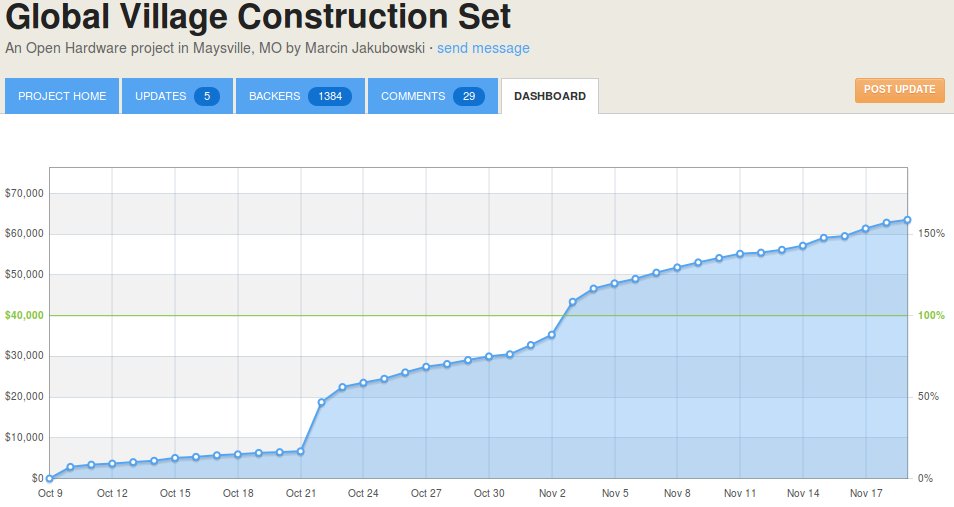Kickstarter
2016
In 2016, OSE teamed up with Open Building Institute to make affordable ecological housing widely accessible.
Here is the intro video from our Open Building Institute Kickstarter. We grossed $116k, or almost double the first OSE Kickstarter of 2011.
2011
We are doing a Global Village Construction Set Kickstarter campaign to assist in the delivery of the OSE Christmas Gift to the World 2011.
See the progress to date:
NEWS: We reached our goal on Nov. 3, 2011, and finished up at over $63k gross. Thank you all the Kickstarter Supporters.
Here is our intro video script:
OSE - “THE LAST MILE” KICKSTARTER SCRIPT
Hi, I'm Marcin, founder of Open Source Ecology (caption: Dr. Marcin Jakubowski, PhD) - the network of farmers, engineers, and supporters building the Global Village Construction Set - a low-cost, high performance, open source DIY platform that allows for the easy fabrication of the 50 Industrial Machines that it takes to build a small, sustainable civilization with modern comforts.
So far, we've prototyped 8 of the 50 Machines - the tractor, compressed earth brick press, soil pulverizer, hydraulic power unit, walk-behind tractor, heavy duty drill press, 150 ton hole puncher, and CNC torch table. We've published the designs, instructions, and budgets on our wiki.
This year - we’ve greatly expanded our development team of technical advisors, CAD designers, fabricators, documentors, and wiki editors - and we’ve struck partnerships with existing open hardware projects like lasersaur, solarfire, and Detroit Fab Lab.
Next year, with help from the Kaufmann foundation, we’ll be developing the next 8 prototypes - The Open Source Microfactory - a set of powerful fabrication tools that enable the transformation of scrap metal into products of advanced civilization.
Before we focus on revolutionizing micro-scale fabrication, we’re dedicating our next push to going “the last mile” with the powerful construction toolset we’ve started - The Tractor, Brick Press, Pulverizer, and Power Cube - a highly integrated product ecology that can have enormous impact right now if we can follow through with the crucial, final stages - field testing, data collection, and full documentation - which will make replication a straightforward reality. And we need your help to do this...
To guarantee our most important deliverable - clear, usable instructions, we’ll be dedicating 1/2 of our kickstarter goal exclusively to documentation. We’re promising a published library of instructional materials that will include, for each machine, the design rationale, 3d CAD files, 2d fabrication drawings, exploded part diagrams, CAE analyses, machine-readable CAM files, circuit diagrams, control codes for automated devices, scaling calculations, the physics of why it works, A to Z instructional videos, and the performance and cost analysis comparison to industry standards. We’ll also provide a user manual that includes the operation, safety, maintenance, troubleshooting, and repair.
Before publishing these final results, we’ll need to put these tools through the most rigorous field test to date - the construction of 6 living units and a 3000 square foot fabrication facility here at Factor E Farm. We’ve already achieved the highest brick pressing rates of any open source model (slide: 16 bricks/minute, 5,000 bricks/day), and now we’re aiming to complete the package - by achieving $5 per square foot construction costs, while remaining within industry standard construction schedules. Our goal is to improve dramatically upon the efficiency of natural building - far surpassing the benchmarks of earthbag, cordwood, strawbale, cob, rammed earth, adobe, earthship, and papercrete techniques, while keeping the ecological footprint to bare minimums. We’ll publish a full energy accounting report, including embodied energy estimates for materials and the “joules per day” of both biological (slide: a human being) and electromechanical systems (slide: of the tractor).
As far as we know, this will be a global first - the highest embodied energy efficiencies, the highest construction efficiencies - at the lowest cost, with the least environmental impact. Our aim with This Last Mile is to lower the barriers to creating sustainable human settlements - by providing access to powerful, low-cost, open source tools that anyone can use for transforming their built environment. Help us go “the last mile” to make this happen. Thank you.
